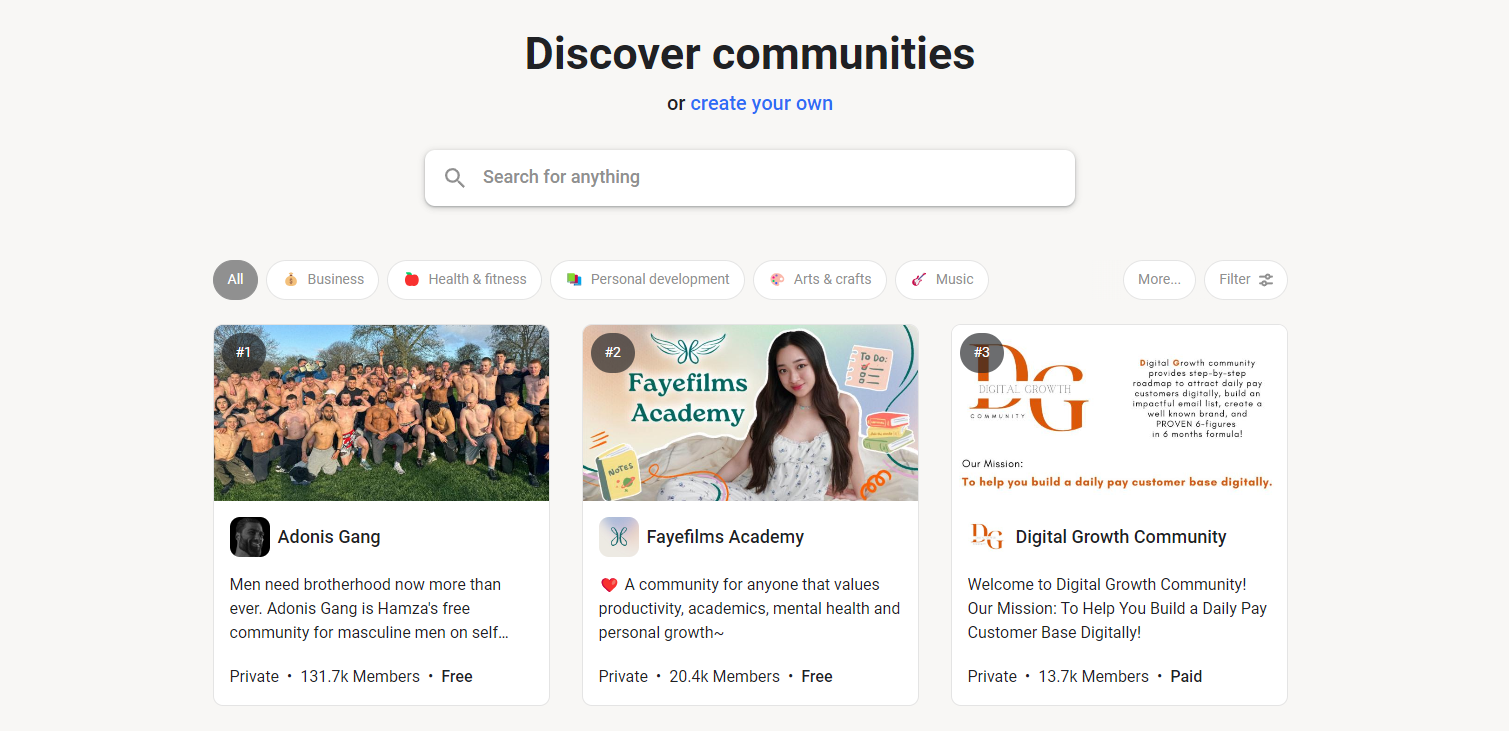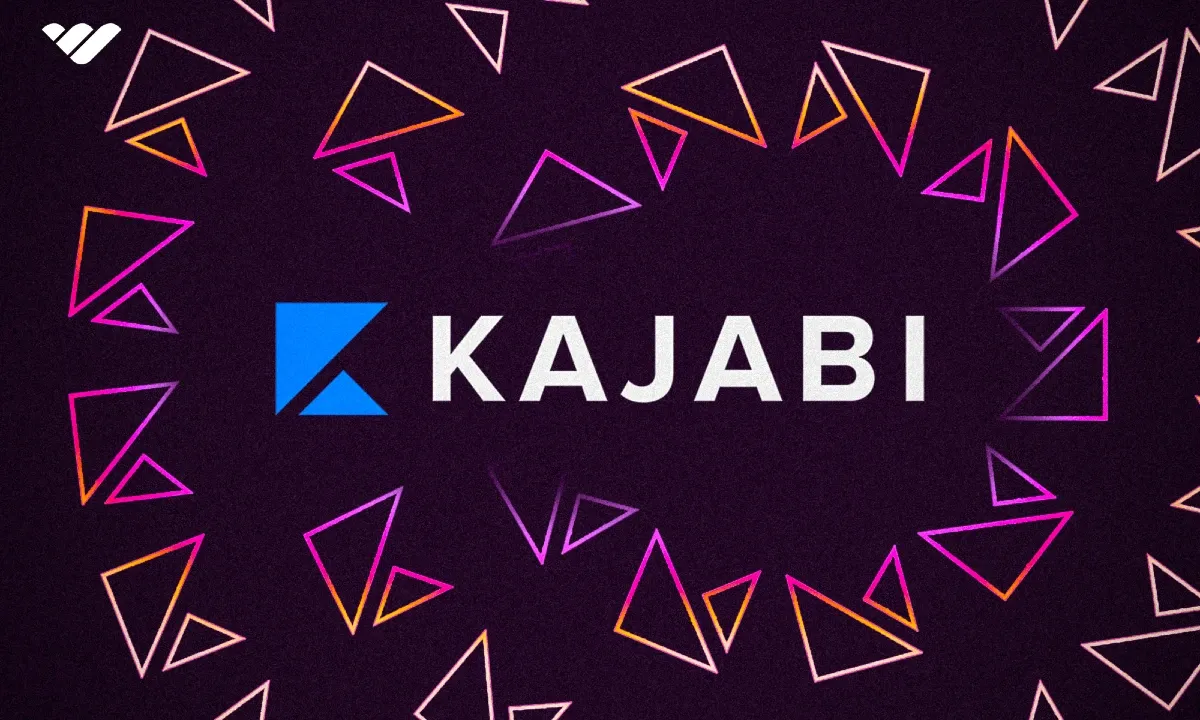Kajabi is an all-in-one platform for creating, marketing, and selling online courses, memberships, and digital products. Learn who can use it and how it works.
Key takeaways
- Kajabi is an all-in-one platform that lets creators monetize digital content without coding skills.
- The platform charges monthly fees ranging from $55 to $399, making it costly for beginners.
- Kajabi takes no commission from sales, only standard Stripe processing fees of 2.9% plus $0.30.
- Creators retain full ownership of their content and can export it anytime.
- The platform works best for established creators earning at least $5,000 monthly revenue.
If you've ever shopped around for a platform to help you monetize your content or sell digital products, you'll almost certainly have stumbled across Kajabi.
It’s a favorite among online entrepreneurs and consistently ranks near the top of Google searches – but what exactly is it, and who is it for?
In this article, we’ll break down Kajabi: what it does, who can use it, how much it costs, and whether it’s the right platform to sell your online courses, coaching, memberships, or other digital products.
What is Kajabi?
Kajabi is a platform for creators looking to turn their content into an online business.
It removes the need for coding, letting entrepreneurs focus on creating and selling digital products like courses, coaching programs, memberships, and more.
The platform provides the tools to design high-quality digital products and the marketing features to promote them effectively.
Its main pillars (courses, coaching, communities, memberships, newsletters, and podcasts) can be combined, too.
Who can use Kajabi?
Kajabi is for anyone who wants to turn their knowledge, skills, or creative content into a business. It’s useful for:
- Coaches and consultants selling programs or 1:1 sessions
- Educators and trainers creating online courses
- Creators running communities, newsletters, podcasts, or memberships
- Entrepreneurs offering digital products like eBooks, templates, or software
If you have valuable expertise or content to share, Kajabi provides the tools to package it, reach your audience, and generate revenue, without needing coding or technical skills.
Kajabi pricing

Kajabi’s pricing reflects its focus on established creators and digital entrepreneurs who already have an audience or customer base.
It’s not ideal for beginners, since monthly fees can quickly eat into smaller revenues.
- Kickstarter plan: The lowest-priced option, less than half the cost of Basic. It’s a way to try Kajabi, but it comes with limits on the number of products, contacts, and active customers.
- Basic, Growth, and Pro plans: Offer more products, marketing tools, and customer management features. Kajabi doesn’t take a cut of your sales, only the standard Stripe processing fee (2.9% + $0.30 per transaction).
The Growth plan works best for creators earning around $5,000 per month, but requires an annual payment of over $1,900 upfront.
Overall, Kajabi suits creators with established digital products, memberships, or coaching programs who can justify the investment with higher revenue potential.
How does Kajabi help creators?
Kajabi helps creators turn their content into a full-fledged business by combining product creation, business management, marketing, and community features all in one platform.
Creating digital products
While Kajabi started as a course builder, today you can sell much more than just courses.
The platform supports online courses, coaching programs, newsletters, memberships, communities, and podcasts.
Templates and design tools make it easy to set up new products or move existing ones to Kajabi, though the platform works best for creators with an established audience.
Managing your business
Kajabi isn’t just a digital storefront; it’s a business hub. Payments are handled through Stripe, ensuring revenue goes straight to your bank account.
Automation tools streamline customer management, analytics, and marketing, saving creators time.
Plus, a mobile app allows seamless access for your audience across devices.
Growing your revenue

Kajabi boosts your earnings with a website builder, landing page templates, and a mobile app to make your content accessible anywhere.
Aside from processing fees, the platform doesn’t take a cut of your revenue, and you retain full ownership of all your content.
Power of community

Kajabi offers resources to help creators level up, including Kajabi University, a library of on-demand resources, and a Facebook group for users to connect, share insights, and collaborate.
What are some Kajabi alternatives?
If you’re noticing a few areas where Kajabi falls short, don't worry.
There are some great alternatives out there that could work for you, and some even go above and beyond.
Here are three to think about:
1. Whop
Whop is the best Kajabi alternative for creators who want the same all-in-one power, without the price tag.
While Kajabi is built for established entrepreneurs, Whop is designed to help anyone start earning from their digital products – fast.
You can sell courses, memberships, communities, SaaS, apps, coaching, templates, or any other kind of offer, all from one dashboard.
It’s also a built-in marketplace, meaning your products can actually be discovered by buyers (not hidden behind your own marketing funnel).
With no monthly fees and lower transaction costs than Kajabi, Whop gives creators a flexible, scalable way to launch and grow without the upfront risk.
2. Skool

Skool is a digital product hosting platform founded by Sam Ovens, which attempts to put community at the centre of the user experience.
It’s been out of beta since 2022 and currently offers course and community creation alongside a native payment system, and innovates through incentivising and gamifying the way students interact with courses.
3. Stan Store

Stan Store is a new entrant to the content monetization landscape, but it takes an approach based on seamless integration with creators’ platforms of choice.
This means that visitors to creators’ stores feature minimal disruption, and it looks and feels just like the original platform that they clicked through from.
Stan Store has a surprising amount of features despite this minimal approach, and its pricing is exceedingly competitive.
Sell with lower fees and more flexibility on Whop
Kajabi is a popular platform for content monetization, but it isn’t for every creator.
Steep pricing structures and product limitations can leave smaller creators or those with diverse digital offerings at a disadvantage.
That’s where Whop comes in.
Whop makes it easy to sell virtually any type of digital product, from courses and communities to software, templates, or ebooks, without restrictive fees or upfront costs.
No upfront fees, no complicated setup, and you can start selling within the hour. Launch your first product on Whop today.
Commonly asked questions about Kajabi
Let's look at some of the most common questions that tend to be asked about the Kajabi platform, to make sure you're aware of all there is to know about Kajabi.
How does Kajabi make money?
Kajabi's revenue comes mainly from creators who sign up with the platform, and depending on their profile and what they want, these creators will be paying Kajabi anywhere between $55 and $399 a month if you exclude their bespoke offers for six-figure creators. Match those figures to Kajabi's claim of having over 100,000 creators, and you can work out roughly where Kajabi's revenues come from.
How do people make money on Kajabi?
If you sign up to use Kajabi, there's no guarantee of making money right away. Kajabi helps to build and grow your revenue streams by giving you tools to easily put digital products together and then market them, but it's on you to do all of that. Kajabi helps you run your content creation business, but doesn't directly boost your earnings.
Does Kajabi take a share of my revenue?
No. Payments on Kajabi are subject to a processing fee because they use Stripe, but Kajabi themselves make their money from the monthly or annual fees you pay to use the platform. This sort of flat fee structure can make a lot of sense if your content is already bringing in five-figure plus revenues, but can get really expensive for any less.
Is Kajabi good for beginners?
Honestly? Probably not. The pricing structure makes it tough if you're just starting out—even the Kickstarter plan at $55/month can eat into your profits when you're still building an audience. You'd need to be pulling in at least a few thousand dollars monthly to make the platform fee worth it. If you're brand new to selling digital products, you're better off with a platform that has lower fixed costs or takes a small percentage instead.
Does Kajabi offer a free trial?
Yes, Kajabi offers a 14-day free trial so you can test out the platform before committing to a paid plan. This gives you enough time to explore the course builder, set up a test product, and see if the interface works for you. Just remember you'll need to enter payment details upfront, and you'll be charged automatically unless you cancel before the trial ends.
Does Kajabi have email marketing built in?
Yep, Kajabi includes built-in email marketing tools as part of all their plans. You can create email sequences, send broadcasts to your audience, and set up automated campaigns without needing a separate tool like Mailchimp or ConvertKit. The email builder is pretty straightforward, and it integrates directly with your products and customer data, which makes segmentation easier.
Can you have a branded webpage with Kajabi?
Yes, and you can use Kajabi's website and landing page builder tools to design the site you want. They've got a solid set of page building tools and a wide selection of templates to make this process as easy as it can be.
How do I cancel my Kajabi subscription?
You can cancel your Kajabi subscription via your dashboard at any time without any red tape. This is an extremely fair feature, but it does explain why Kajabi discounts their annual subscriptions compared to the monthly ones!
Does Kajabi own my content?
No. As a content creator, you retain all rights to the intellectual property that you put on the Kajabi Portal, and you can export it to another platform whenever you want.



